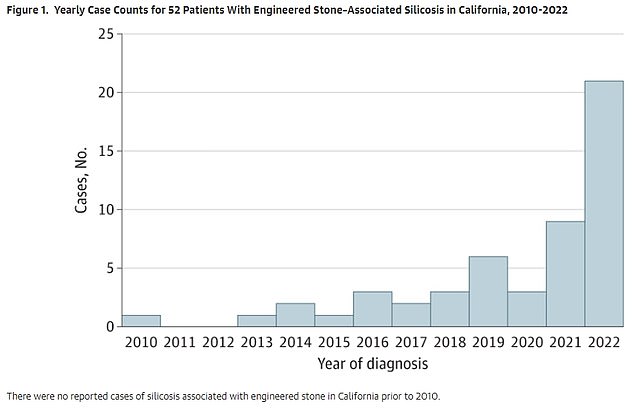Doctors warn of a “new and emerging” epidemic driven by sleek, extremely durable quartz countertops.
The dust released when the stone is cut is inhaled by workers and causes irreversible scarring of the lungs, leaving patients with difficulty breathing and a painful cough.
Known as silicosis or “black lung,” it is incurable, killing a considerable number of patients and leaving many in need of a double lung transplant.
The condition was previously thought to be disappearing, with fewer than five cases recorded in California each year, but since 2019 scientists in the state have recorded at least 70 cases.
University researchers of California, Los Angeleswarn that A new type of quartz countertop that contains more silica is behind the increase, as it releases more silica when cut, causing more scarring in the lungs and increasing the risk of disease. They also warn that doctors are underdiagnosing the disease.
In their study, the scientists found that up to four out of five cases of silicosis were missed on initial examination; instead, patients were more likely to be told they had a lung infection. This delayed critical and potentially life-saving treatment.
They also found that in 48 percent of cases, patients had “atypical” features in their lungs, or changes that would not normally be seen on scans.
Dr. Sundus Lateef, a radiologist who led the analysis, said: “This is a new and emerging epidemic, and we must increase awareness about this disease process so we can avoid delays in the diagnosis and treatment of our patients.”
Above is Marek Marzec from the UK, who was diagnosed with silicosis at the age of 48. He had spent a decade working with quartz countertops while working as a stonemason.

Marzec claims his employer did not have safe working conditions and did not take steps to minimize the risk of employees breathing in the toxic particles.
In the study, presented at the annual conference at the Radiological Society of North America in Chicago, researchers examined CT scans and lung function tests of 55 workers diagnosed with the disease.
They were all male, Hispanic, around 43 years old, and were exposed to silica dust for an average of 18 years.
Each was also symptomatic, with most suffering from shortness of breath and/or cough, and living in an urban area outside of Los Angeles.
In a preliminary analysis of 21 patients, researchers found that only four cases (or 19 percent) were correctly diagnosed at their initial visit by primary care physicians.
In the case of radiologists, they found that only seven patients (33 percent) were correctly diagnosed on their first visit.
In most cases, researchers found that patients were given alternative diagnoses, such as an infection.
Doctors warned that a new type of countertop was behind the rise in cases, which is called artificial quartz and is made by bonding quartz fragments with a resin. It usually contains much more silicon.
Inspections show that more than half of California workplaces that cut quartz exceed the maximum allowable limit for airborne silica dust.
Workers can reduce their exposure by wearing face masks or using a cutting machine that sprays water on the stone at the same time, preventing silica dust from rising into the air.

The image above shows a quartz countertop in a kitchen. Releases silicon dust while cutting, which can increase the risk of lung diseases for workers.

The above shows the case count per year of patients diagnosed with silicosis. It is based on 52 cases and the graph was published last year.
But researchers say many of the workers in these industries are immigrants and Hispanics, who are vulnerable to exploitation.
Dr Lateef added: ‘There is a critical lack of exposure and screening of workers in the artificial stone manufacturing industry.
“It is necessary to promote earlier detection and defense of this vulnerable population, which in our case were Spanish-speaking immigrant workers.”
It is estimated that more than 2 million construction industry workers in the United States are exposed to silica dust each year.
Scientists say it poses a risk because of the small airborne particles that workers can breathe, causing scarring of the lungs.
The American Lung Association says that after 10 to 30 years of working with stone, workers can experience nodules forming in their lungs, which reduce lung capacity and make it difficult for them to breathe.
In severe cases, a condition called progressive massive fibrosis (PMF) can arise, in which extreme scarring stiffens the lungs, which normally move with each breath, making it difficult to breathe.
They also warn that patients may need oxygen and other devices to help them breathe.
Doctors say there is no cure for this disease, which also increases the risk of other health problems such as tuberculosis, lung cancer and chronic bronchitis.
In a study of 52 cases of silicosis published last year, doctors found that ten patients had died (20 percent), while 11 were referred for lung transplants, of which three received them.

